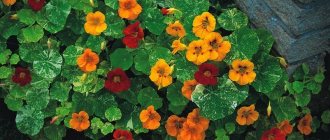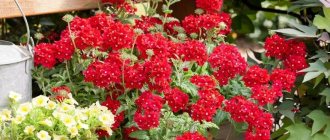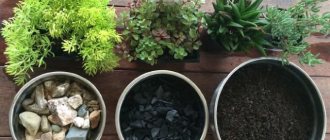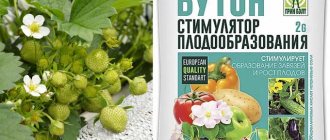The name “violets” is so firmly attached to the delicate and touching Saintpaulias that the true representatives of the Viola genus are often forgotten in rooms. But not the most suitable for potted format and living spaces, charming pansies can decorate summer window sills and balconies. They are short-lived and require attention, but they reproduce easily. And among the compact, beautifully flowering plants, it is difficult to find equally touching and bright crumbs. The choice of violets is so wide that there is a suitable option to decorate any home.
Viola on the balcony and in the rooms - advantages and disadvantages
What garden violets can grow indoors?
Collected in basal rosettes and sitting alternately on the stems, bright, oval, decorated with beautiful rounded teeth along the edges, violet leaves are almost invisible under their flowers. Single, but blooming in surprisingly large numbers for such a small bush, they flaunt larger lower petals with funny outgrowths at the base and seem irresistible.
With a diameter of 4 to more than 10 cm, viola flowers attract attention with a bright yellow eye, velvety texture of the petals, unique and easily recognizable asymmetry, and an inimitable variety of petal shapes.
Only a few types of garden violets are used as a potted plant to decorate rooms or balconies, most often without distinguishing between “pansies”:
- Wittrock violet (Viola x wittrockiana);
- tricolor violet (Viola tricolor).
They come in numerous hybrid varieties prized for their delightfully varied blooms.
Garden violets (Viola) have always been considered a universal plant and perfect even for novice gardeners. But for potted violas, their status as an unpretentious plant is less relevant. And when transferring to a container format, you should first of all think about the few but obvious disadvantages. It is no coincidence that this garden plant never became the star of greenhouse and interior design.
Wittrock's violet (Viola x wittrockiana). © Koichi Oda
Tricolor violet (Viola tricolor). © Lana37rus
Sowing seeds in open ground
So that beautiful fragrant flowers appear every summer, a biennial or perennial flower is grown if planted in June or July in the ground.
To begin with, they decide on the place of cultivation. Viola prefers loamy, slightly moist soil. The place is chosen with slight shading . When placed in the shade, the petals will be pale and small in diameter.
In the shade, the plant blooms twice as long compared to plants in a sunny area.
Drainage can be pebbles or broken bricks. 2-3 cm of sand is poured onto the drainage layer and leveled. Then the soil is filled in (a mixture of equal amounts of garden soil and humus).
Small grooves are made at a distance of at least 10 cm from each other, and seeds are sown in them. Next, the seeds are sprinkled with a little soil, and the soil is moistened. To maintain moisture levels, the grooves are filled with sawdust. The emerging sprouts are shaded from the bright sun. For this purpose, a dark film is used or tree branches are stuck next to the flowerbed.
The abundance of flowering depends both on the correct location and on care after planting in a permanent place.
Disadvantages of potted-balcony violas
Violas are not the most suitable plants for the potted format; they require certain conditions to be created at home and on the balcony. Only a few accommodation options will suit them. And before you decide to consider them as more than just a garden plant, you should weigh all the possible risks. After all, in order for the viola to bloom tirelessly and look fresh, it will still need special attention.
Daily care is the first thing to think about. Even in the garden, lack of moisture leads to the fact that instead of luxurious bushes you have to look at limp, lifeless plants. But if in open ground and flower beds violas come to life in the morning, then on a windowsill or balcony, mistakes in watering can be disastrous.
Even a short drought affects the leaves; you can water the plant only so that the top layer of the substrate dries slightly - avoiding dampness and stagnation of water, but also without lack of moisture. For violas, you will have to water twice a day in the summer, only in the early morning or evening. And without an automatic watering system, this drawback is difficult to mitigate.
It is no easier to satisfy violets’ love for fresh air. They bloom poorly and suffer even on a glassed-in balcony, and on a windowsill they require a special approach. Without constantly opening the doors, refreshing ventilation and free air circulation, nothing will work. This does not mean that it is impossible to grow viola on a windowsill. Can. But with the window slightly open and following all the recommendations as scrupulously as possible.
Viola on balconies is suitable only for those who can provide it with regular care. If you have a trip planned or you are often not at home, and there is no one to care for the plants every day, it is better to exclude it from candidates for landscaping balconies.
Viola on balconies is suitable only for those who can provide her with regular care
Propagation of viola in a pot: the most common methods
Growing a magnificent viola in a pot or container is as easy as growing it in open ground. It is enough to know the basic methods of reproduction and their features. To propagate viola yourself, there are several methods of propagation: seed, seedling method and cuttings.
Seed propagation of viola in a pot
- It is best to start growing viola from seeds in February, so that after transplanting into pots it can bloom soon.
- First of all, you need to buy plant seeds and soil mixture for sowing.
- It is important to soak the seeds in Epin solution for a day.
- Pour the purchased soil mixture into a suitable spacious box. If you want to plant viola seedlings in large pots outside in the future, then it is better to sow more seeds.
- Make shallow grooves on the surface and sow seeds in them, then carefully cover with soil.
- After sowing, the surface must be moistened with a spray bottle and the container covered with glass or film.
- Viola seeds should germinate at a temperature of 15 degrees.
- The first seedlings begin to appear within a week, after which the glass is removed and the container is moved to a cooler room with good lighting.
- At this stage, watering and fertilizing with mineral fertilizers is important.
- When a couple of true leaves appear on the seedlings, it is recommended to plant the seedlings in separate small cups.
- After about 2-3 weeks, viola seedlings can be planted in suitable pots. It is important to remember that if the pots are voluminous, then you need to adhere to the 6*6 cm scheme.
Propagation of viola in a pot by cuttings
- Another method of propagating viola is cuttings, thanks to which you can immediately obtain a large number of young plants.
- To start propagation, you need to use an adult viola bush in a pot. Thus, throughout the entire season, you can cut cuttings on the viola and root them, obtaining new seedlings.
- The best time for this method is May or June.
- First of all, it is necessary to prepare cuttings that are pinched off on an adult plant. It is important that each cutting has 3 nodes.
- Next, you need to prepare the soil mixture for rooting. To do this, you can mix garden soil with perlite and sand.
- Root the cuttings into a common container so that one node is in the soil.
- In the future, it is necessary to regularly moisten the soil.
- After about 3-4 weeks, the cuttings will be completely rooted and can be transplanted into suitable pots and flowerpots.
The main advantages of a viola on the balcony and in the room
But all the shortcomings pale before the extraordinary beauty and brightness of the flowering of garden violets. Even the violas moved to the balcony are still charming. And it is very difficult to find an indifferent grower to their beauty.
The main advantages of viola as a balcony plant include the following.
colorful bloom
Few can compete with violas in the beauty of the structure of asymmetrical flowers, their size and color scheme. Small “eyes” and touching veins, watercolor transitions, a combination of dozens of shades or the most dazzling colors - violas always look catchy. Viola flowers remind some of butterflies, others - of magical characters, funny faces and curious elves. But it’s very difficult not to be captivated by their beauty.
Growing nasturtium at home
The peculiarity of nasturtium is its underdeveloped root system, which facilitates its cultivation at home, where there are no strong winds and watering can be regulated. On balconies this plant begins to bloom earlier than on the street, which is also a plus.
Nasturtium can be climbing or ampelous. The first has rather long stems, reaching a length of up to 2 meters, the shoots of the second are less long - up to 30 cm. There are also dwarf varieties in the form of small bushes, the height of which is approximately 15 cm. They are usually planted in separate flowerpots rather than in common ones containers. Growing nasturtium on a balcony has a number of peculiarities due to its fragility, but with proper care it will delight its owners with wonderful flowers that bloom throughout the summer season.
Nasturtium on the balcony
Planting nasturtium
Like petunia, nasturtium is grown from seedlings, which are sown in March-April. Before sowing, the seeds are soaked in water and left for a day, and then buried in the soil to a depth three times their size. The soil should be moderately moist; warm water is used for irrigation. After sowing, containers with seeds are covered with glass or polyethylene, forming a kind of greenhouse.
Since the root system of nasturtium is very weak and is located close to the surface, it is advisable to sow the seedlings in containers from which the sprout can be easily removed along with the earthen lump. This will protect the fragile plant from damage and allow it to be planted in a common container without any problems. Peat or other pots with a removable bottom are used as such containers. Such pots should be shallow and wide enough.
Within two weeks the first shoots appear. Seedlings should be periodically hardened off during growth, weather permitting. To do this, on warm sunny days, the pots are taken out onto the balcony for several hours.
Transplanting into balcony containers
The soil for nasturtium is loose and light; loamy and sandy loam soil without nitrogen impurities is suitable. The presence of the latter leads to a reduction in the number of flowers and active growth of stems.
Growing nasturtium on the balcony
Nasturtium seeds can be planted directly into balcony containers without waiting for the seedlings to germinate in separate pots. Often these two methods are combined. Seedlings take a long time to take root, and seeds germinate quickly, so there won’t be much difference between them. The distance between plantings in containers is 20 cm. Containers must have drainage, otherwise excess moisture will lead to rotting of the already weak roots. Hanging nasturtiums are immediately planted in separate hanging pots, bypassing the seedling stage. Planting is carried out indoors, and the flowerpot is taken out to the balcony when it gets warm.
Nasturtium is a heat-loving plant, so frosts and sudden temperature changes are destructive for it. For this reason, it should be planted on the balcony no earlier than mid-May, when the threat of a drop in temperature has passed. Landing takes place on a cloudy day.
Nasturtium care
Despite the fact that nasturtium is photophilous, exposure to direct sunlight can harm it, so it is not advisable to grow it on the south side. On the northern side, where there is almost always shade, it feels good, but blooms worse. In addition, this fragile plant is afraid of strong winds, so it is better not to grow it on open balconies and on upper floors. It is more suitable for loggias or fully glazed structures.
The soil in a flowerpot or general container should be moderately moist and in no case too dry. Drainage is installed to remove excess moisture. Before the buds appear, the plant is watered abundantly, and then watering is reduced. To improve flowering, fading flowers are picked before they fall off.
It is necessary to feed nasturtium before flowering at the stage of vegetative development. Complex fertilizers diluted with water are used as fertilizing. The frequency of watering is once a week. It is better not to use nitrogen-containing fertilizers - they reduce the intensity of flowering; phosphorus components are used to increase the number of flowers. An affordable and effective way to fertilize is to fertilize with ash, which stimulates the appearance of buds. To prepare the nutritional mixture, 10 g or 5 teaspoons of ash are diluted in 1 liter of water. It must be used before flowering begins, after which feeding stops.
The main enemies of nasturtium when grown on a balcony are spider mites, aphids, cabbage moths and cruciferous flea beetles. To combat spider mites, you can use alcohol (not technical alcohol!), which you need to spray the plant with. As an option, chemical compounds sold in flower shops are also used. The same ash, sifted through a sieve, can successfully deal with other pests. The resulting powder is sprinkled on the leaves and stems, after which the insects disappear. This should be done on a calm day so that the ash does not blow away from the plant.
Of the diseases of nasturtium, the most common is gray rot, the cause of which is the botrys fungus. It appears as gray-brown spots on leaves and stems. Treatment consists of spraying the plant with a 1% solution of Bordeaux mixture at the stage of vegetative development. All affected areas are removed and burned.
Conditions and care for indoor violas
To succeed in growing violas on balconies, and even more so on window sills, you need to take care of ideal care and special conditions:
- the most bright and diffused lighting (the violet is not afraid of direct sun, but not at noon, not on the southern balcony and not in the middle of summer, and strong shading without at least a few hours of morning or evening sun is destructive; viola grows best on western and eastern balconies , and in rooms - on south windows with a screen);
- temperature from 10 to 25 degrees, with short cold spells and protection from heat;
- error-free regular watering with stable average air humidity;
- weekly fertilizing with special fertilizers for violets, annuals, or at least beautifully flowering plants (starting from the second week after planting);
- laying very high drainage (even for miniature containers - 2-3 cm);
- choosing loose, breathable and very nutritious soil;
- carrying out regular loosening of the soil (ideally weekly);
- regular pruning of faded parts and timely cutting of shoots that lose their decorative effect and dry out - half to stimulate growth and a second wave of flowering (to a height of 5-6 cm, leaving a few leaves on each shoot).
Don't forget about one more advantage. The ease of replacement and the absence of fear of transplants, even in a blooming state, make it possible to replace a violet that has lost its decorative effect with a new young bush. If the variety is disappointing, or due to failures in care, the violets have lost their decorative properties, you can easily plant new flowering plants to replace them.
Viola ampelous or horned
Viola ampelous (horned) is usually grown as an annual. Sometimes it can be saved until next season. The plant is a spherical bush with half-meter shoots, but the total height of the bush does not exceed 20 cm. The flowers are small and large. Depending on the variety, the diameter of the flowers can reach up to 4 cm.
Viola ampelous
The leaves of the crop are oval-elongated, the flowering period is very long - from spring to frost. The petals are bright and can be plain or multi-colored.
Of no small importance are:
- cultural tolerance to sudden changes in temperature;
- fast growth;
- rapid entry into flowering.
Ampelous viola in a flowerpot
Ampel is translated from German as “hanging flowerpot”. The very name “ampel viola” speaks about its purpose. Although at the beginning of the growing season the shoots grow vertically, but closer to the beginning of flowering they begin to bend down like a waterfall. The more buds, the more they fall. This property indicates the advisability of their use in hanging flowerpots.
Varieties of ampelous viola
More than 200 species of violas grow on earth. In modern times, dozens of ampelous varieties of the crop have been bred. Breeders work tirelessly to create new ones.
Cool Wave Mix Improvd
One of the most popular is the ampelous viola Cool Wave Mix Improvd. The variety has outstanding shoots. Canes of 75 cm are covered with flowers of various shades. The buds are large. The diameter of the flower is about 5 cm. At the same time, the bush is compact. The height is only 15 cm (below the average value for the culture).
Viola ampelous Cool Wave Mix Improvd
Perfect for decorating recreational areas and using to decorate flower beds.
Interesting! The variety is suitable for use as a ground cover plant.
Old Spice Mix
Old Spice Mix is a unique type of culture. The bushes are compact, with a diameter of no more than 25-35 cm. There are many colorful buds on long shoots. Each flower has its own individual scent. By the way, they can be used for food.
For better decorativeness, it is better to keep the plant in partial shade.
Viola ampelous Old Spice Mix
Viola Hederacea ampelous
Australia is considered the birthplace of Hederacea ampelae. Although not the most popular, the variety nevertheless quickly spread across the American continent, Europe and Russia. The reason for this can be attributed to the flowering of the plant in calm, pearly tones. The color of the petals is more similar to lavender. But the foliage is very beautiful. The leaf blades themselves are large, and their color is bright green.
Viola Hederacea ampelous is an unpretentious flower, but it should be planted only after the cessation of return frosts.
Viola Hederacea ampelous
Diseases and pests
Harmful insects often attack viola, but they are easy to get rid of. The most common are spider mites. Signs of a tick attack: yellow spots appear on the leaves, a thin web can be seen on the underside, after which the foliage dries out. Plants are sprayed with Karate, Zeon or Magus before pests attack all leaves.
Sometimes brothers get sick with the following diseases:
- Spot from the genus Alternaria occurs; it is necessary to combat it with fungicidal preparations.
- Yellowish or brown spots are visible on the upper side of the leaf blade, and a light coating on the lower side - these are symptoms of downy mildew. Plants should be sprayed with one of the following preparations: Agrecol Anti-Mushroom, Aliette.
Seedling care
We figured out how and when to plant pansies, and now a few words about care. Viola is quite unpretentious, but will fully show its charm only under optimal conditions. For example, under the scorching sun a bush can burn, and in partial shade the flowers lose their brightness and become smaller. Before planting seedlings, it is advisable to fertilize the soil with compost and rotted manure at the rate of 5 kg per “square”. Please note that the flower cannot tolerate fresh manure.
In the future, pansies, the care of which also consists of loosening the soil and watering, can be periodically fed. For example, before budding, water with water with nitroammophos dissolved in it (take a tablespoon of fertilizer into a bucket). Before flowering, add a tbsp to the bucket in the same way. spoon of superphosphate and water. We are not lazy to remove weeds so that they do not choke the plantings.
Viola is prone to cross-pollination, so unexpectedly you may suddenly become the only owner of a specimen with an unusual pattern or color. In this case, you can collect the seeds and sow them next year. You need to collect the seeds when the capsule turns white or yellow. It is important not to miss the moment before it opens and the seeds spill onto the ground. The plant is quite winter-hardy, but still overwinters better under a layer of spruce needles. You cannot cover the bushes with leaves or sawdust - with frequent thaws, they will simply get wet.
Description of the pansy plant
To successfully grow pansies on the balcony, you need to study the life cycle of the plant, its flowering characteristics and care rules.
Viola (lat. viola) is a herbaceous plant that belongs to the Violet family. In nature, it can be found in Europe and temperate regions of Asia.
The height of the plant is 10-30 cm, depending on the species. The shoot is branched, triangular, hollow inside, erect or creeping. One stem or several can emerge from the root at the same time. The root of the garden violet is tap-type, lightly branched and brown in color.
- The leaves in the upper part of the shoot are sessile with short petioles, oblong-lanceolate. The plates are arranged alternately on the stem. In the lower part of the stem, the leaves are broadly ovate with long petioles.
- Viola flowers are five-petaled, flat, and of different colors. They are solitary, appearing from leaf axils.
- The fruits are oblong-ovoid capsules up to 10 mm in size. They begin to ripen in June, when the valves open and seeds spill out.
The plant is a perennial, but is mainly grown as a biennial.
Pansies are also grown on the balcony in Russia
Viola varieties
Numerous varieties of these flowers are hybrids of several types of violets. All varieties are widely used in floriculture to create borders, flowering carpets, flower beds, ridges, as well as for decorating windows and balconies.
Viola can be compact or spreading bushes. Violas are distributed throughout the globe. The most common groups among our flower growers are as follows:
- Erfurt early,
- Swiss grandiflora (Roggli),
- trimardo profusely flowering.
Pansies have an incredible variety of colors and colors, the most popular is viola tricolor - the top of the petals are purple, the middle petals are yellow and the lower petals are light yellow or white.
Perennials or annuals?
Pansies can be grown as annual or perennial flowers. It all depends on the climatic conditions in which the plants are grown and the labor you are willing to put in. These flowers are quite frost-resistant, but even in central Russia they are not always able to survive the cold winter. Particularly vulnerable are plants that were planted late, had little growth and went into winter weakened.
Viola does not tolerate wintering well in winters with little snow; spring thaws followed by night frosts are especially dangerous for flowers.
In order to prevent the viola from freezing, you need to avoid low, damp places for planting, cover the flowers with covering material for the winter, and in winter carry out snow retention in the flower bed with pansies.
In order for the viola to bloom earlier, it is better to cover the flowerbed with film in early spring. Growing annual viola is a more predictable process.











